In July 1976, as NASA's Viking 1 spacecraft orbited Mars, a couple of its photographs included coverage of a geographic
region designated as Cydonia. Strewn with rocky mesas and devoid of dried river channels, this landscape did not strike
NASA as an inviting target for their next lander mission to search for traces of possible ancient life.
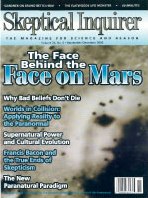 But when the photos were released to the public, one of the many mesas seen in Plate #035A72 captured the national
spotlight because of its striking resemblance to a humanoid face, complete with headdress (see right). Speculation then
arose in some quarters that perhaps this mile-long structure was not a natural surface feature at all, but rather an
artificial monument. But was it constructed by a once-thriving Martian civilization? Was it erected by beings from
elsewhere in the galaxy, during a brief junket through our solar system, perhaps as a "calling card" for when we became
a space-faring species? Or might earthlings -- from our own future -- be responsible?
But when the photos were released to the public, one of the many mesas seen in Plate #035A72 captured the national
spotlight because of its striking resemblance to a humanoid face, complete with headdress (see right). Speculation then
arose in some quarters that perhaps this mile-long structure was not a natural surface feature at all, but rather an
artificial monument. But was it constructed by a once-thriving Martian civilization? Was it erected by beings from
elsewhere in the galaxy, during a brief junket through our solar system, perhaps as a "calling card" for when we became
a space-faring species? Or might earthlings -- from our own future -- be responsible?
The person most intimately associated with the "Face on Mars" is Richard C.
Hoagland, a gifted speaker and author of the 1987 book The Monuments of Mars: A City on the Edge of
Forever. Yes, a "City." For within 035A72, Hoagland and his associates believe they have also discovered
evidence of, among other relics, a "fortress," an artificial "cliff," a "five-sided pyramid
. . . apparently damaged by explosive penetration [that] seems to possess
. . . the proportions of humanoids [with] its 'head' pointing directly toward the
[more-famous] 'Face'" (italics in original), and a
collection of structures dubbed the "City Square."
According to Hoagland,
the city may date back approximately 500,000 years to a time when, if one had stood in the middle of the City Square,
"the Summer Solstice sun would have arisen directly over the 'Face'."
But by 1990, despite the popularity of Hoagland's book, there still appeared to be no NASA program in the works to
aggressively explore Cydonia. Yet, to hear Hoagland tell it, all was about to change dramatically, thanks to his
efforts.
At that time, Hoagland was serving as Science Advisor to the For The People radio program, which was based
in Cedar Key, Florida, and broadcast daily across the United States on the Sun Radio Network (and worldwide via
shortwave). Hosted by Chuck Harder, this "overheated radio talk show" (as described by Alex Heard in his June/July 1991
Air & Space Smithsonian article) was devoted partly to useful consumer-oriented advice, and partly to
conspiracy and fringe-science themes such as UFOs, suppressed cancer cures, and perpetual energy machines.
Given the nature of much of the subject matter, the program's Florida roots, and my position as founder
of the Tampa Bay Skeptics (and editor of its newsletter, TBS Report), I began taping some of the broadcasts, saving and cataloging the most preposterous comments (winding up with nearly five hours of priceless "Greatest Hits" snippets, many involving Hoagland), and writing about them in TBS Report. [June 2015 Update: I have now
posted these audio snippets, with comprehensive annotations and time stamps, and have also created new links to various documents referred to in this article and the audio.]
Hoagland Speaks at NASA
My initial inquiries into some of Hoagland's pronouncements on For The People had concerned the first of his two
1990 presentations (March 20 or 21 -- sources differ) at the NASA Lewis Research Center in Cleveland, Ohio [watch the entire presentation here]. In a May 13, 1990, Letter to the
Editor of TBS Report, Chuck Harder had claimed that
NASA invited [Hoagland] after their own internal investigation of the [Cydonia] photos gave his mission sufficient
credibility to ask him . . . to present the program to 4,000 NASA scientists and employees. Hardly a laughing
matter. . . . Thus on the
"NASA ALERT Presentation -- Was There Life on Mars?" I suggest you contact Joyce E. Bergstrom at NASA. I have photocopied her
business card (attached).
At Harder's suggestion, I wrote to Bergstrom on May 19. And on June 5 she telephoned me, only too happy to clarify the
circumstances surrounding Hoagland's presentation at NASA/Lewis. She explained that the Lewis center "brings in speakers
on a variety of topics of interest as an employee perk. They can legally charge their time for one hour away from their
job to go to the auditorium to listen to a colloquium." Regarding the "ALERT" designation attached to the title of his
presentation, Bergstrom told me that ALERT is just a "catchy acronym" for Alert Lewis Employees on Relevant Topics, and
connotes no special importance to the subject matter. And as for this being "no laughing matter," Bergstrom
chuckled at the suggestion that Hoagland's invitation had resulted from "an internal investigation by NASA giving
sufficient credibility" to his claims, saying, "No, sir. Not at all. Hoagland was invited to the center by our director
as a guest for the day based on an employee's recommendation that he would have an interesting subject." She added that
no NASA scientist had ever expressed to her a belief in Hoagland's theories about Mars. [April 2001 Update: NASA's "Lewis" center has since been renamed in honor of John Glenn.]
On the July 13 For The People program, Hoagland discussed his March presentation at NASA/Lewis. Among his
statements was one to the effect that NASA's Dr. John Klineberg, as he introduced Hoagland, credited him with playing a role
in President Bush's decision that we reinvigorate our exploration of Mars. But Klineberg informed me (in an October 24, 1990,
letter) that his remark was "of insufficient gravity to be quotable" since he had "no insight" into any such connection.
Lewis's Director of Internal Affairs, Americo F. Forestieri, had
written to me on October 4 saying, "I understand
[Klineberg's] remark was made with tongue in cheek."
During the same July 13, 1990, FTP broadcast, Hoagland said that his second NASA/Lewis invitation was to address an
upcoming September 11 "major national NASA education conference." On the September 17 FTP program, he described
what had been "a packed auditorium full of teachers and scientists and engineers and educators." He added that NASA's Dr. Eddie
Anderson had "made a very big point of congratulating me, of expressing his interest in our work." But,
according to Forestieri,
This conference . . . [of] the NASA/Oklahoma State University Aerospace Education Services Project
. . . was attended by about 50 people. . . . To say this was a "major NASA education conference"
and that "the auditorium was full" would be stretching it a bit. . . . According to Dr. L. Bondurant, the
organizer of the conference, Mr. Hoagland was invited to speak at this conference "to stretch the peoples' minds [and]
give them something to think about." Dr. Eddie Anderson's comment to me, when I
asked him your question, was that he was just being a genial host in expressing interest in Mr. Hoagland's findings. He
made no comment as to their veracity. . . . I took the liberty of contacting some of the people that worked
on the Viking program [and] also some working on the proposed new mission to Mars, and they are not aware of any interest
in Mr. Hoagland's claims.
Hoagland also announced on September 17 that NASA was preparing a three-part "miniseries" on his presentations, entitled
Hoagland's Mars, to air on PBS. He added, "I and Carl now both have our own miniseries," as if to compare his
to Sagan's award-winning series Cosmos. In a November 5, 1990, telephone conversation, I learned from Craig De Sagnick,
a contract video production manager to NASA/Lewis, that the original two-show project had been reduced to a single,
half-hour program about Hoagland's March presentation, which would carry a disclaimer making clear that Hoagland's
theories were his own and not NASA's (the second half-hour production was deemed of insufficient technical quality to
warrant a TV show being made). He told me that NASA produced between 13 and 26 new shows per year on a variety of
space-related topics, which any individual PBS station could elect to broadcast if it so wished.
Dubious Claims for Due Credit
On July 6, 1990, Hoagland accused Omni magazine of "the height of editorial irresponsibility." What
prompted him to vent his outrage to the international FTP audience? In its July article about a hypothetical
"Mars Rover" mission to Cydonia, according to Hoagland the magazine "ascribed to Carl Sagan [my] work on
. . . the pyramids and all the other things that are there." But the article referred to the "face" as merely
a "mesa . . . named for its resemblance to human features," not as an artificial structure. And there were no
references to the rest of Hoagland's "work," although Sagan did refer, metaphorically, to the region's mile-high mountains
as "beckoning pyramids."
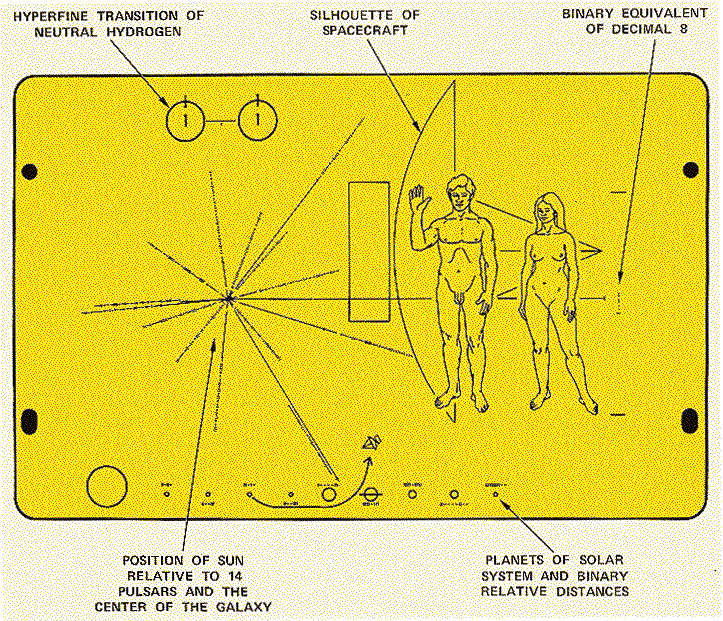 Speaking of Sagan,
the Pioneer 10 plaque and its elegant message (click image on right) have always to me epitomized his poetic genius.
But Hoagland told the FTP audience on July 13, 1990, that "Carl for many years has been taking public credit
for the Pioneer plaque which, of course, Eric Burgess
and I conceived." On a broadcast later that year (November 16) he added
that "Carl . . . was involved with Eric Burgess and me in the design of [the] message." And in the
Publisher's Foreword to The Monuments of Mars we find this passage:
Speaking of Sagan,
the Pioneer 10 plaque and its elegant message (click image on right) have always to me epitomized his poetic genius.
But Hoagland told the FTP audience on July 13, 1990, that "Carl for many years has been taking public credit
for the Pioneer plaque which, of course, Eric Burgess
and I conceived." On a broadcast later that year (November 16) he added
that "Carl . . . was involved with Eric Burgess and me in the design of [the] message." And in the
Publisher's Foreword to The Monuments of Mars we find this passage:
Among Hoagland's most valued contributions to history and science is the conception, along with Eric Burgess, of Mankind's
First Interstellar Message in 1971, an engraved plaque carried beyond the solar system by the first man-made object to escape
from the sun's influence, Pioneer 10. Hoagland and Burgess took the idea to Carl Sagan, who successfully executed it aboard
the spacecraft and acknowledged their creation in the prestigious journal Science.
When I inquired of Carl Sagan as to the precise nature of Hoagland's role in the "creation" and "design" of the
Pioneer 10 plaque,
Sagan's reply of September 6, 1990, made clear that "Eric Burgess and Richard
Hoagland did no more than suggest to me that a message be put aboard Pioneer 10 and 11. Frank Drake and I, with an assist
from Linda Sagan [Carl's wife at the time, who prepared the artwork], did the design, and I was responsible for getting it
through the NASA and
White House approval process. . . . [Hoagland] did not contribute one bit of data towards the message design."
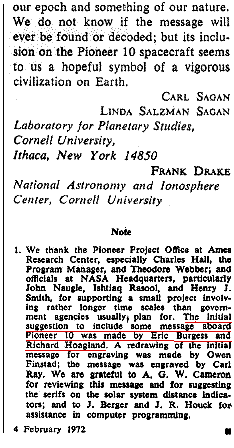 Frank Drake confirmed Sagan's account (September 27 and October 18):
"Neither Eric Burgess nor Richard Hoagland contributed any ideas or even suggestions as to what should be on the Pioneer 10,
and no suggestions as to any message content. They did point out that Pioneer 10 was going to leave the solar system and
it would be nice to put some form of message on it. That was as far as their involvement went. I am sure that Eric Burgess
would be glad to confirm this. . . . The idea that there should be an engraved plaque, and the type of information
which should be engraved, was developed mutually by Carl and me. . . . I remember very clearly that we started
with completely open minds as to what the message should be, and without any prior suggestions as to possible message
content."
Frank Drake confirmed Sagan's account (September 27 and October 18):
"Neither Eric Burgess nor Richard Hoagland contributed any ideas or even suggestions as to what should be on the Pioneer 10,
and no suggestions as to any message content. They did point out that Pioneer 10 was going to leave the solar system and
it would be nice to put some form of message on it. That was as far as their involvement went. I am sure that Eric Burgess
would be glad to confirm this. . . . The idea that there should be an engraved plaque, and the type of information
which should be engraved, was developed mutually by Carl and me. . . . I remember very clearly that we started
with completely open minds as to what the message should be, and without any prior suggestions as to possible message
content."
In a note of acknowledgements (see right) at the conclusion of Sagan and Drake's February 25, 1972, Science
article entitled "A Message from Earth,"
Burgess and Hoagland are credited with the "initial suggestion to include some
message aboard Pioneer 10." But as Hoagland acknowledges on
page 98 of his own book, it was actually Burgess who
first said to Hoagland, "It ought to carry a message." (Then, on the next line,
Hoagland claims that he had already thought of the idea: "That was the unvoiced thought, which had been
nagging at me ever since I'd gazed in through [the craft's] thick quartz windows" (italics in original). [March 2025 Correction: Hoagland's phrase "thick quartz windows" actually referred to the protective vacuum chamber housing the spacecraft at the time.]
At Drake's suggestion, and thanks to his tip in helping me locate Eric Burgess (who had been a writer for the Christian Science
Monitor at the time of the Pioneer 10 project), I telephoned Burgess, who told me the following (and subsequently
mailed me a copy of the Epilog to his 1982 book, By Jupiter: Odysseys to a Giant, in which he recounts a virtually identical sequence of events):
I came up with the idea [that the craft carry a message from Earth]. And I mentioned it [at lunch that afternoon]
to Hoagland [then a freelance
writer] and Don Bane [Los Angeles Herald Examiner]. . . . And I said that the right man to get this onboard
would be Carl Sagan. So I went around to JPL [NASA's Jet Propulsion Laboratory] -- Hoagland was in tow with me -- and found
Sagan. . . . And I said, "Hey, Carl, I've got an idea for you." All Hoagland did was support me and say
it's a good idea. [June 2011 Update: Jerry Pournelle has similar recollections.]
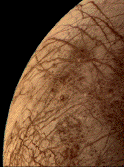
Hoagland is also widely believed to have been the first to deduce the tantalizing notion of an ocean,
possibly harboring life, flowing beneath the icy crust of Europa (right), one of the moons of Jupiter.
Even Arthur C. Clarke, in an acknowledgment at the end of his book 2010: Odyssey Two (his sequel to
2001: A Space Odyssey), credits Hoagland:
The fascinating idea that there might be life on Europa, beneath ice-covered oceans kept liquid by the same Jovian tidal
forces that heat Io [Jupiter's volcanic moon], was first proposed by Richard C. Hoagland in the magazine
Star & Sky ("The Europa Enigma," January 1980 [accessible from the very bottom of
this page]). This quite brilliant concept has been taken
seriously by a number of astronomers (notably NASA's Institute of Space Studies, Dr. Robert Jastrow), and may provide
one of the best motives for the projected GALILEO Mission.
But late into my preparation of this article (in fact, some days after I first posted its precursor on my Web site), I came
across the "Europa" Web site of
Ralph Greenberg, a
professor of mathematics at the University of Washington in Seattle, who has been attempting for several years, without
success, to have Hoagland clarify the record on Europa. One night in July 1996, Greenberg was listening to Art Bell's
wildly popular late-night Coast to Coast A.M. radio program.
Bell's guest was Richard Hoagland,
who proceeded to accuse NASA of preparing to steal the credit
for his own original ideas about Europa.
Hoagland singled out a particular NASA scientist, Cornell University's Steven Squyres, as one who had already
begun the process earlier that month during a scientific meeting in England. Greenberg knew nothing
of these matters, but was disturbed that Hoagland would make such an accusation, in a national venue,
on the basis of a newspaper account of that meeting. (It turned out that Squyres had made no claim to having been
the idea's originator.) As Greenberg relates on his
Web site, "During Hoagland's [later] frequent guest appearances, Art Bell would often mention some recent news item about
Europa and either he or Hoagland would bring up the subject of Hoagland's 1980 article, always giving the impression that
it was he who first proposed [the idea]. Art Bell would then usually add some sarcastic comments about the scientific
community not giving Hoagland his due credit." [Note: Hoagland and Bell have also
intentionally misrepresented my own words (see and listen here).]
Then, in early 1997, Greenberg happened to see an article in Science News mentioning that the idea of a
liquid-water ocean under the ice of Europa had first been proposed in 1971 by John S. Lewis. Taken somewhat aback, Greenberg
decided to do a little more digging, and found that a series of additional scientists had also chimed in with concurring articles
throughout the 1970s. And he found at least three scientists who, prior to 1980, had speculated publicly about
the possibility that life might have evolved in such an ocean (Robert Shapiro, Gerald Feinberg, Benton Clark), as well as
science-fiction writer Duncan Lunan.
In his 1980 article, Hoagland clearly does acknowledge (on page 28) that "it was
[space scientists] Cassen, Peale and Reynolds who arrived at the estimate [of] Jupiter's tidal influence upon [Europa]. . . .
Those energies should produce . . . internal heating." Hoagland
shortly thereafter offers the following, which one might incorrectly assume to be an original flash of extrapolated insight:
"Unless . . . There, in the tidal calculations, was the provocative potential that beneath a thin, outer
shell of ice, the bulk of Europa's planetary ocean was still ocean" (italics in original). He doesn't mention that this
was the central point of the scientists' paper, and that it was entitled "Is There Liquid Water on Europa?" (Geophysical
Research Letters, Vol. 6, September 1979).
When Greenberg sent to Arthur C. Clarke (and others) six pages summarizing the history/chronology of this evolving view
of Europa, Clarke replied that "I have [since] become aware of the fact that many others had thought of it first, as you
point out." But Clarke also expressed his enduring gratitude to Hoagland for his "excellent 1980 article [which was] my
first introduction to the idea."
Indeed, the Monuments of Mars Publisher's Foreword makes Hoagland sound like somewhat of a science prodigy:
Richard C. Hoagland is, by career, a science writer as well as a consultant in the fields of astronomy, planetarium
curating, and space-program education. . . . In 1965, at the age of nineteen
, [Hoagland] became Curator
(possibly the youngest in the country) of the Springfield, Massachusetts, Museum of Science. . . . In 1966
Hoagland served as NBC [Television] consultant for the historic soft landing of a U.S. spacecraft on the moon --
Surveyor 1. Later he appeared on "The Tonight Show" explaining the significance of the landing to Johnny Carson.
. . . At Christmas [of 1968, for the Apollo 8 lunar-orbital mission] he was asked to become a consultant to
CBS News . . . and served as [a science] advisor to Walter Cronkite. [January 2025 Update: This August 2000 Springfield Journal article discusses an "ambitious project" being undertaken in 1965 by "a popular planetarium lecturer at the Springfield Science Museum, 19-year-old Richard Hoagland," but makes no mention of his having been the museum's Curator.]
But I learned from Dr. David Morrison, Chief of the Space Science Division at NASA's Ames Research Center, that Hoagland
was largely "self-educated" in science. In an August 31, 1990, letter,
Morrison told me that he knew of "no one in the
scientific community, or who is associated with the NASA Mars Science Working Group, or who is working on Mars mission
plans at such NASA centers as Ames, Johnson, or JPL, who ascribes even the smallest credibility to Hoagland or his weird
ideas about Mars." So much for the "groundswell of official NASA interest" that Hoagland boasted of during his July 13
For The People appearance.
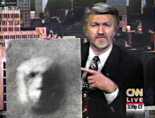


 Frank Drake
Frank Drake 